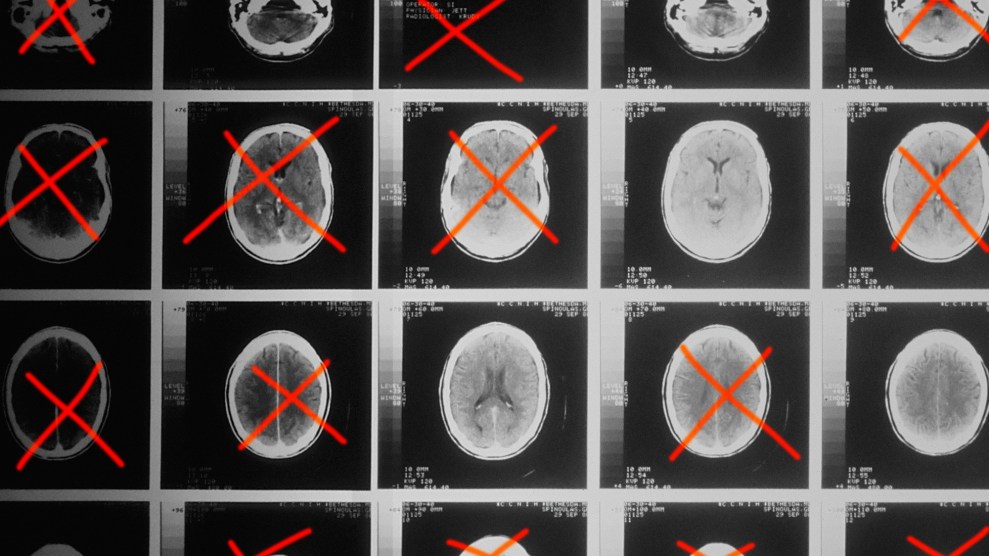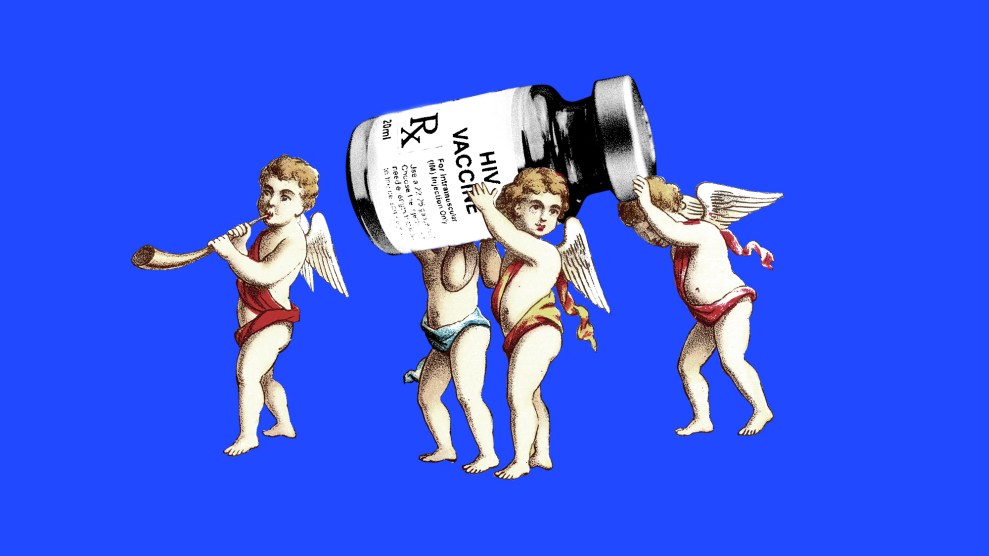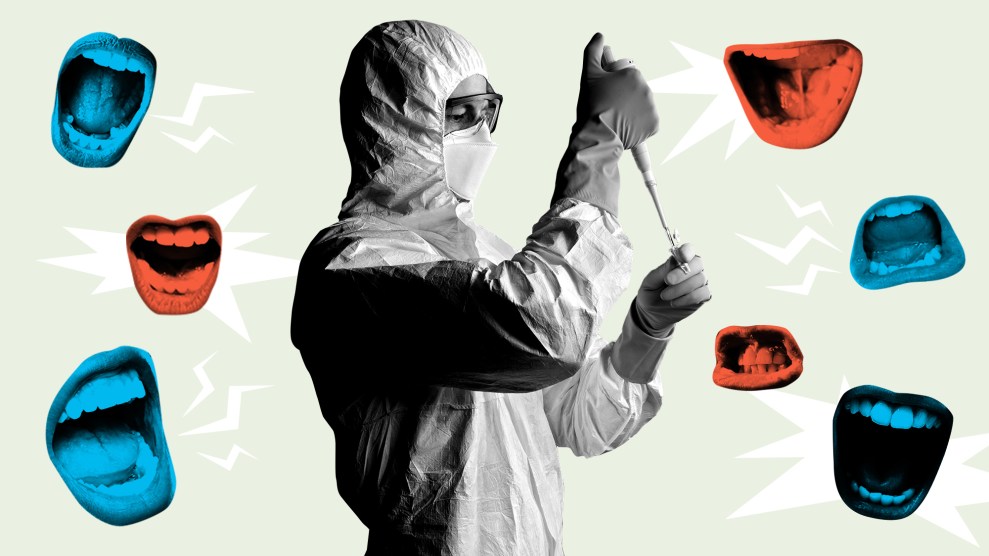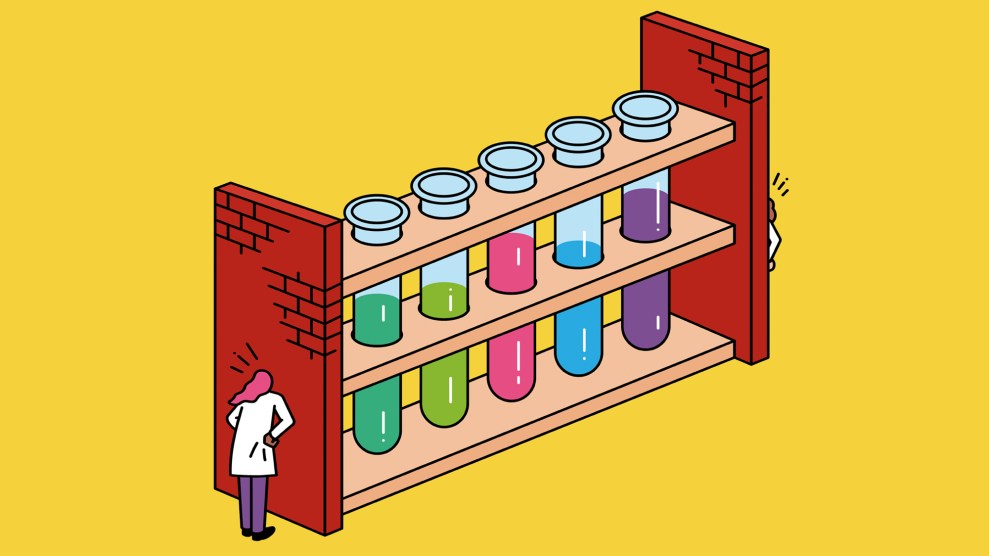
Mother Jones illustration; Unsplash
More than 15 years ago, researchers at the University of Minnesota announced they had made a breakthrough: When they purified a protein from the brains of genetically modified mice and injected it into rats, it would cause the rats to develop symptoms similar to Alzheimer’s disease in humans—the first time anyone had directly linked a substance to the disease. They called this protein Aβ*56.
The researchers, along with colleagues from three other universities, published their findings in Nature in 2006. The study has since been cited about 2,300 times and helped provide the basis of a leading hypothesis about the cause of Alzheimer’s, a disease that currently impacts about 6 million Americans and their families. Proponents of the hypothesis think that clumps of amyloid beta protein (Aβ) in people’s brains may be the primary cause of Alzheimer’s. Since the Nature study showed that Aβ*56, one form of the protein, could cause dementia in rats, it seemed to validate the hypothesis.
But now, the accuracy of the Nature paper has been called into question. As documented in an explosive report in Science that published on July 21, whistleblower Matthew Schrag discovered evidence to suggest that some of the images at the center of the 2006 paper were tampered with, along with dozens of other images connected to one of the authors, University of Minnesota neuroscientist Sylvain Lesné.
Schrag, a neuroscientist and physician at Vanderbilt University, brought the questionable images to Science reporter Charles Piller’s attention last year. Schrag had originally come across Lesné’s work on PubPeer, a website where people can anonymously discuss scientific studies. He found repeated examples of what looked like tampering, particularly with Western blot images, which are used to identify proteins. Then, Schrag looked into the 2006 paper—and found more evidence of possible manipulation. To be clear: Without access to the original research, the published images alone aren’t proof of fraud. And Schrag “does not claim to have proved misconduct,” Piller notes. But Schrag’s findings, which Piller ran by several top Alzheimer’s researchers, raise serious questions about one of the field’s most influential studies and others based on it. “Some Alzheimer’s experts now suspect Lesné’s studies have misdirected Alzheimer’s research for 16 years,” Piller writes—not to mention millions of dollars in federal funding.
On July 14, Nature published an editor’s note on its 2006 study, saying it plans to investigate “concerns regarding some of the figures in this paper.” Karen Ashe, the senior author of the study, recently called for it to be retracted, “citing that confidence in [the study] has been undermined,” CNBC reports. (When I reached out to Ashe for comment, she told me she maintains “absolute confidence” in the team’s research on Aβ*56. “While the editing of select images should not have occurred, the adjustments are non-material, inconsequential, and have no bearing on the research findings themselves,” she said; Lesné did not directly respond to a request for comment from Mother Jones.)
To better understand what his investigation may mean for Alzheimer’s research, academic publishing, and the public’s trust in science broadly, I spoke with Piller over Zoom last month. You can read an edited and condensed version of our 45-minute conversation below:
In your article, you share an example of an image with signs of tampering. Out of all of the images you had to choose from, why did you include that one? And what is it showing?
That was selected 1) because it was from the all-important Nature paper. And 2) is because it offered an opportunity to show a certain technique that Schrag used that is incredibly compelling. The imaging technology of Western blots displays as a series of stacked bands. And Schrag was able to go in and examine two sets of bands that were adjacent to each other in the image. Through digital imaging methods, he was able to essentially align them and colorize them in a way so that you could overlay the bands and see which sections were exactly the same. And it turns out that some of these bands were almost completely identical—suggesting that these bands had been cloned.

An example of a Western blot image
So if the bands had been duplicated, what were the implications of that? How did it change the meaning of the image?
We’ve seen evidence of basically every kind of possible manipulation you can find. In some cases, it’s suggesting that a protein was there when it wasn’t there. Or it could be to change the amount of protein that was found in a particular sample. Or in some cases, we found that it indicated that proteins occurred earlier or later in the lifespan of the mice.
This is important for a few reasons. One is that the timing of when these proteins appear is central to the amyloid hypothesis. If you change the sequence, it raises questions about whether that hypothesis is correct, as described. The second thing is, if someone is doing things that look to be an example of possible misconduct, in even one element of an experiment, can you trust anything that’s in there?
In reading through your story, one of the themes that came up for me was the role of science publishing in all this. What do you think the role of journals like Nature should be in verifying the images they’re publishing?
Let me take it one step back and answer that question more broadly. So what institutions are responsible for policing potential misconduct in important scientific work? There’s the funder, which is often the National Institutes of Health. There are the universities where these folks work. And third, there are the journals that peer review this work before publishing it.
I think historically, the journals have not done a very good job. They haven’t hired the right people to implement techniques to do this sort of image evaluation on a routine basis. It takes time and money, but people are not doing it as much as they should be doing it. And the other thing, of course, is the embarrassment factor. Journals are slow to retract articles that might have problems, or to issue what they call “statements of concern” associated with them. It can sometimes take months or even years for this to happen. That’s pretty much inexcusable. [Editor’s note: When asked about the role publishers should play in vetting images, a Nature spokesperson told Mother Jones that while the journal does have tools to identify signs of data tampering, “publishing is a system that is to some extent predicated on trust, as is research itself.”]
Matthew Schrag submitted a dossier on Lesné to the National Institutes of Health. When NIH receives claims like this, first they do an evaluation, which can take months. Then they give it to the Office of Research Integrity, which is a separate agency within HHS. Then the Office of Research Integrity evaluates whether it’s something that’s worthy of an investigation. And if so, they give it to the university where the research took place. In other words, they give it to the very institution that has the most to lose and the least to gain by doing an aggressive, vigorous investigation of possible misconduct. And what happens? Well, often, it takes a really, really, really long time. And the result is not very satisfying to people who fear that misconduct occurred. It happens over and over and over.
One of my favorite quotes in this piece was from Schrag: “You can cheat to get a paper. You can cheat to get a degree. You can cheat to get a grant. You can’t cheat to cure a disease. Biology doesn’t care.” And it really resonated with me because as I was reading this, I kept thinking, why would someone tamper with images in this way? Because if the science is faulty—any drugs based on that science probably aren’t going to work, right? And that’s the whole point of this research, to treat and cure Alzheimer’s. It made no sense to me. Did you struggle with that at all?
I’ve thought about it a hundred times. It’s a very compelling question. And I’m not a psychologist, I don’t know what may have gone through Lesné’s mind. But I can imagine a circumstance in which a person is convinced of the truthfulness of their work, they’re convinced that this is something that really is important. And it means something. But they can’t quite get the experiment to work. So they say, “Well, I know this is right, I’m just going to change one little thing here.” And lo and behold, nobody notices.
And so they think, “Oh, well, that went well, and now I’m on to the next thing.” And the series of actions build on each other. In my experience, people who are engaging in conduct of this kind, there’s never a one-off. It’s always a series of things. And eventually, I hope, in most cases that it catches up with them because you’re absolutely right—if their findings are based on false information, it’s not going to result in a cure, or in any kind of effective work downstream.
Do you have a sense of what motivated Schrag to spend so much time doing all this sleuthing?
Schrag is a physician. He’s a researcher into Alzheimer’s and he treats patients. And for him, it just goes to the heart of who he is as a person, which is to say, he’s dedicated his career to treating and trying to cure this disease and other neurological problems. And it just became impossible for him to ignore the tainting of the scientific record that has the potential to set back the cause of curing this disease. And he felt that if he could help clean that up and force the scientific community to face up to it, it would be a big contribution. And I think his view is correct. And he’s rare. Not very many people are willing to do that. [Editor’s note: Before coming across Lesné’s work, Schrag had been paid to investigate another, unrelated case of possible data tampering in research associated with the development of an Alzheimer’s drug, Simufilam. The company manufacturing the drug denies any misconduct. It’s also worth noting: In either of the cases involving Lesné or Simufilam, “if federal authorities determine fraud occurred and demand a return of grant money, Schrag might be eligible to receive a portion of the funds,” Piller writes.]
One of the researchers you speak to, Dennis Selkoe, worried that the Lesné episode, as you write, “may further undercut public trust in science during a time of increased skepticism and attacks.” Is that something you thought about too? And if so, how do you think journalists can ensure that writing about incidents like these doesn’t further cause people to lose trust in science?
It’s an important question that I’ve struggled with many times and, in particular, struggled with in this story. I would say, yes, I view it as a hazard. And here’s an example of why: A few days ago, Tucker Carlson did an item on my story. His treatment of it was distorted and incorrect. And it was used as a kind of a bludgeon on science and the credibility of science. I think that’s regrettable. Other right-wing media outlets have done similar things. So that’s always a hazard—you can’t control what the world’s going to make of the work that you do.
But my view is that there’s really no alternative but to expose this sort of possible wrongdoing, for the reasons that Schrag told me. Namely, it’s vital to clean up a polluted area of research. Also, many scientists think that by showing that they can be part of the process of exposing wrongdoing in their own ranks, they can engender public trust more than by just looking the other way.
So as the scientific community responds to this story, it may be a chance to build trust?
In the media environment we live in, it’s hard to say if being forthright and self-examining and being willing to confront error and potential misconduct in your own ranks will really build trust. But the alternative is worse. The alternative is to allow that sort of activity to have a deeply harmful, and I think, pernicious effect on the very work that you’ve dedicated your life to.














